Introduction
Love is one of the most complex and profound emotions experienced by humans. It has been a subject of fascination for philosophers, poets, and scientists alike. From an evolutionary perspective, it plays a crucial role in human survival by promoting bonding, reproduction, and social cohesion (Fisher, 2004). However, in recent decades, neuroscience has provided remarkable insights into the biological and chemical processes underlying it.
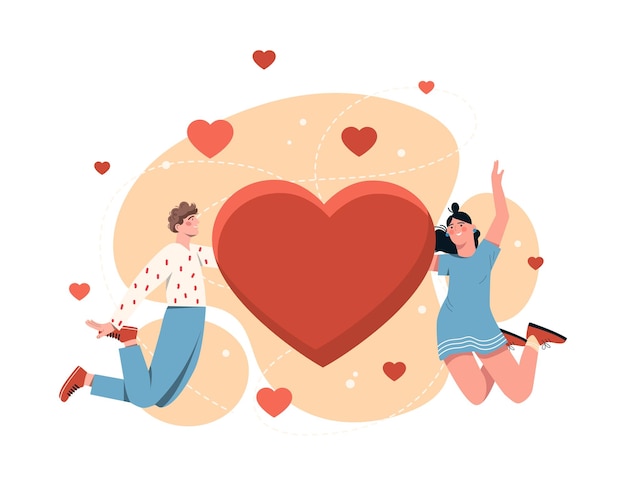
Read More- Mental Health
The 3 Phases of Love and How Your Brain Reacts
Helen Fisher, a renowned biological anthropologist, proposed that it can be categorized into three overlapping but distinct stages : lust, attraction, and attachment (Fisher, 1998). Each of these stages is associated with different neural mechanisms and hormones involved in love. Following are the phases of love-
1. Lust
Lust, or sexual desire, is primarily driven by the hormones testosterone and estrogen in both men and women. These hormones are regulated by the hypothalamus, a small region in the brain that controls essential bodily functions, including sexual behavior (Sokolowski & Corbin, 2012).
- Testosterone- This hormone plays a significant role in increasing libido and sexual motivation. Studies show that men and women with higher testosterone levels tend to have higher sexual desires (Archer, 2006).
- Estrogen- Although it is commonly associated with female reproductive health, estrogen also influences sexual arousal and receptivity in both genders (Carter, 1998).
These hormones heighten physical attraction and sexual motivation, ensuring reproduction and the continuation of our species. Studies suggest that increased testosterone levels correlate with higher attraction and pursuit behavior in romantic contexts.
2. Attraction
Attraction is the phase in which individuals develop a strong romantic interest in a specific partner. Neuroscientific studies using functional magnetic resonance imaging (fMRI) have shown that the brain’s reward system is highly active during this stage (Aron et al., 2005).
- Dopamine- This neurotransmitter is the primary driver of attraction, stimulating pleasure and motivation. It is produced in the ventral tegmental area (VTA) and released into the nucleus accumbens, creating feelings of excitement, pleasure, and obsession (Fisher, 2004).
- Norepinephrine- This chemical, closely related to adrenaline, increases heart rate, energy, and focus, leading to the common “butterflies in the stomach” sensation (Marazziti & Canale, 2004).
- Serotonin- Interestingly, serotonin levels drop during the attraction phase, resembling levels found in individuals with obsessive-compulsive disorder (OCD) (Marazziti et al., 1999). This explains why people in it often obsess over their partners.
Functional MRI (fMRI) scans show that people in love have brain activity patterns similar to those seen in individuals with addiction, suggesting that love can be as intoxicating as drugs.
3. Attachment
Attachment is the phase that sustains long-term relationships, whether romantic or platonic. It is influenced by two key hormones:
- Oxytocin- Often called the “love hormone” or “cuddle chemical,” oxytocin is released during physical touch, orgasm, and childbirth. It promotes trust, bonding, and long-term connection (Young & Wang, 2004).
- Vasopressin- This hormone is linked to monogamy and partner fidelity. Research on prairie voles, known for their monogamous relationships, found that vasopressin plays a crucial role in pair bonding (Young et al., 2001).
Studies show that couples with higher levels of oxytocin tend to stay together longer and report higher relationship satisfaction.
Which Brain Regions are Involved in Love?
Different areas of the brain contribute to the experience of love. fMRI studies have identified several regions that become active when individuals think about their romantic partners.
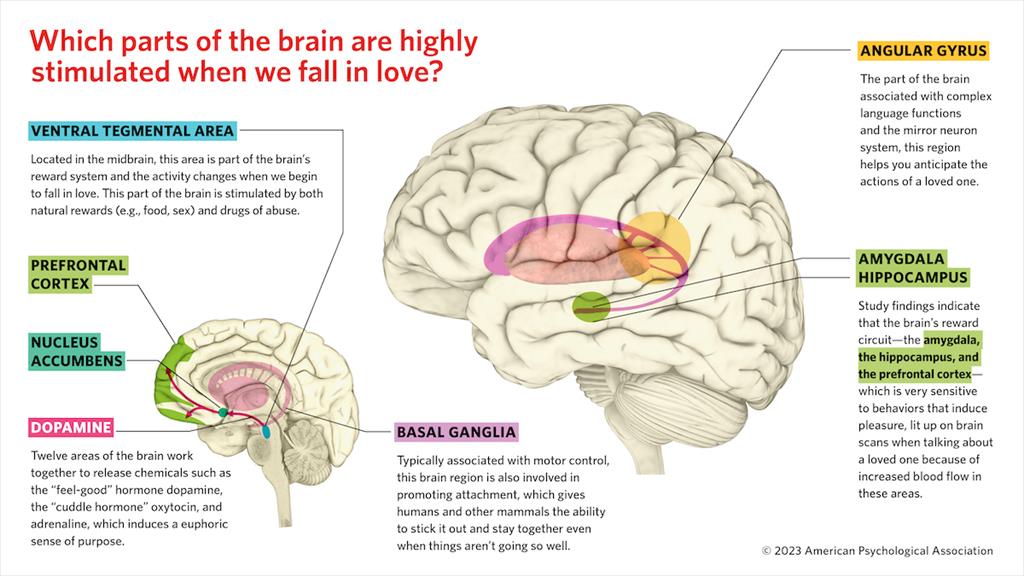
- Ventral Tegmental Area (VTA)- This area is rich in dopamine and is crucial for feelings of pleasure and reward (Fisher et al., 2005).
- Nucleus Accumbens- Responsible for motivation and reinforcement, this area is highly active in people experiencing romantic love (Aron et al., 2005).
- Hippocampus- Involved in memory formation, it helps individuals recall past experiences with their loved ones (Bartels & Zeki, 2000).
- Prefrontal Cortex- This region is associated with decision-making and social behavior. Love influences our judgments and increases risk-taking (Zeki, 2007).
What are the Types of Love?
Neuroscience suggests that different types of love engage distinct but overlapping brain systems.
- Romantic Love- Romantic love activates the reward system, reinforcing the motivation to be with a partner. The anterior cingulate cortex and insula also become active, explaining why love is often linked with emotional pain and longing (Bartels & Zeki, 2000).
- Parental Love- The bond between a parent and child is mediated by oxytocin and dopamine. A study by Swain et al. (2008) found that mothers viewing images of their infants showed activation in the amygdala and hypothalamus, areas associated with nurturing and protection.
- Platonic and Companionate Love- Friendship and deep, non-romantic attachments are also influenced by oxytocin. While they lack the intensity of romantic love, they engage brain regions associated with trust and empathy, such as the orbitofrontal cortex (Zeki, 2007).
What Brain Region is Involved in Heartbreak and Pain?
It is not always a positive experience. When relationships end, the brain responds similarly to physical pain.

- Anterior Cingulate Cortex- This region, responsible for pain perception, is activated during social rejection (Eisenberger et al., 2003).
- Amygdala- Involved in emotional processing, it becomes overactive during heartbreak, leading to anxiety and distress (Fisher et al., 2010).
- Decreased Dopamine Levels- The drop in dopamine levels post-breakup can contribute to depression and withdrawal symptoms (Fisher, 2004).
Conclusion
Love is a complex experience deeply embedded in the brain’s neurobiology. From the initial excitement of attraction to the long-term security of attachment, different neurotransmitters and brain regions work together to create and sustain it. Advances in neuroscience have allowed researchers to map love’s effects on the brain, offering insights into why we form relationships and how they shape our behavior.
While it is often seen as a mysterious and poetic force, it is, at its core, a finely tuned interplay of biology and chemistry. Understanding these mechanisms not only deepens our appreciation of it but also offers potential avenues for addressing relationship challenges, mental health issues, and emotional well-being.
What do you think about love? Share your thoughts in the comments!
FAQ: Common Questions About the Neuroscience of Love
1. What brain chemicals are involved in love?
Dopamine, oxytocin, serotonin, and norepinephrine play key roles in love, influencing attraction, bonding, and emotional responses.
2. Why does love make you obsessed?
During the attraction phase, serotonin levels drop, resembling patterns seen in obsessive-compulsive disorder (OCD). This explains why people in love often obsess over their partners.
3. How does heartbreak affect the brain?
Heartbreak activates the anterior cingulate cortex (pain perception) and amygdala (emotional processing), leading to feelings of distress and anxiety.
4. What brain regions are involved in romantic love?
Key regions include the ventral tegmental area (VTA), nucleus accumbens, hippocampus, and prefrontal cortex.
References
Archer, J. (2006). Testosterone and human aggression: An evaluation of the challenge hypothesis. Neuroscience & Biobehavioral Reviews, 30(3), 319-345.
Aron, A., Fisher, H., Mashek, D. J., Strong, G., Li, H., & Brown, L. L. (2005). Reward, motivation, and emotion systems associated with early-stage intense romantic love. Journal of Neurophysiology, 94(1), 327-337.
Bartels, A., & Zeki, S. (2000). The neural basis of romantic love. NeuroReport, 11(17), 3829-3834.
Eisenberger, N. I., Lieberman, M. D., & Williams, K. D. (2003). Does rejection hurt? An fMRI study of social exclusion. Science, 302(5643), 290-292.
Fisher, H. (1998). Lust, attraction, and attachment in mammalian reproduction. Human Nature, 9(1), 23-52.
Fisher, H. E. (2004). Why We Love: The Nature and Chemistry of Romantic Love. Henry Holt and Company.
Young, L. J., & Wang, Z. (2004). The neurobiology of pair bonding. Nature Neuroscience, 7(10), 1048-1054.
Subscribe to PsychUniverse
Get the latest updates and insights.
Join 2,971 other subscribers!
Niwlikar, B. A. (2025, February 13). The Neuroscience of Love: 3 Stages and What Happens in Your Brain. PsychUniverse. https://psychuniverse.com/neuroscience-of-love-brain-hormones-phases/
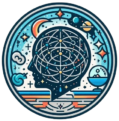
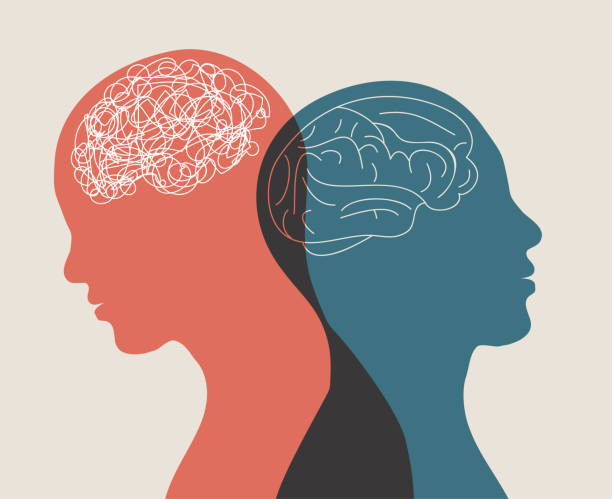
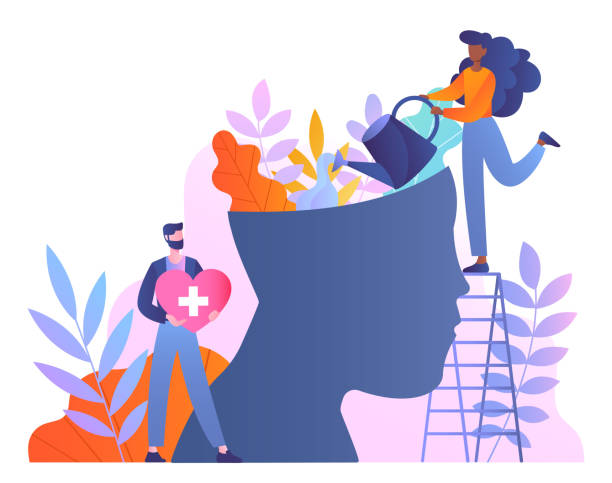
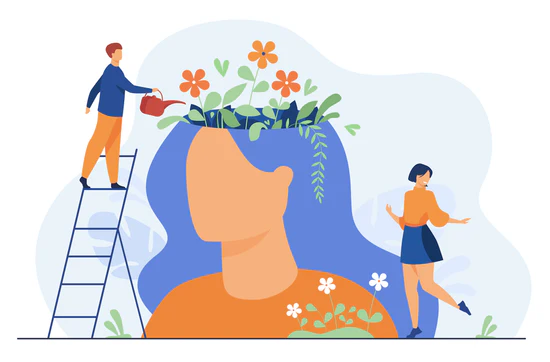
Pingback: What is Gaslighting and 5 Important Ways to Counteract It - PsychUniverse
Pingback: Tapestry of Human Connection: Importance of Relationships and Their Impact on Psychology - PsychUniverse